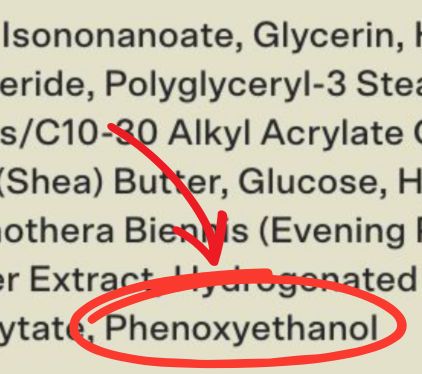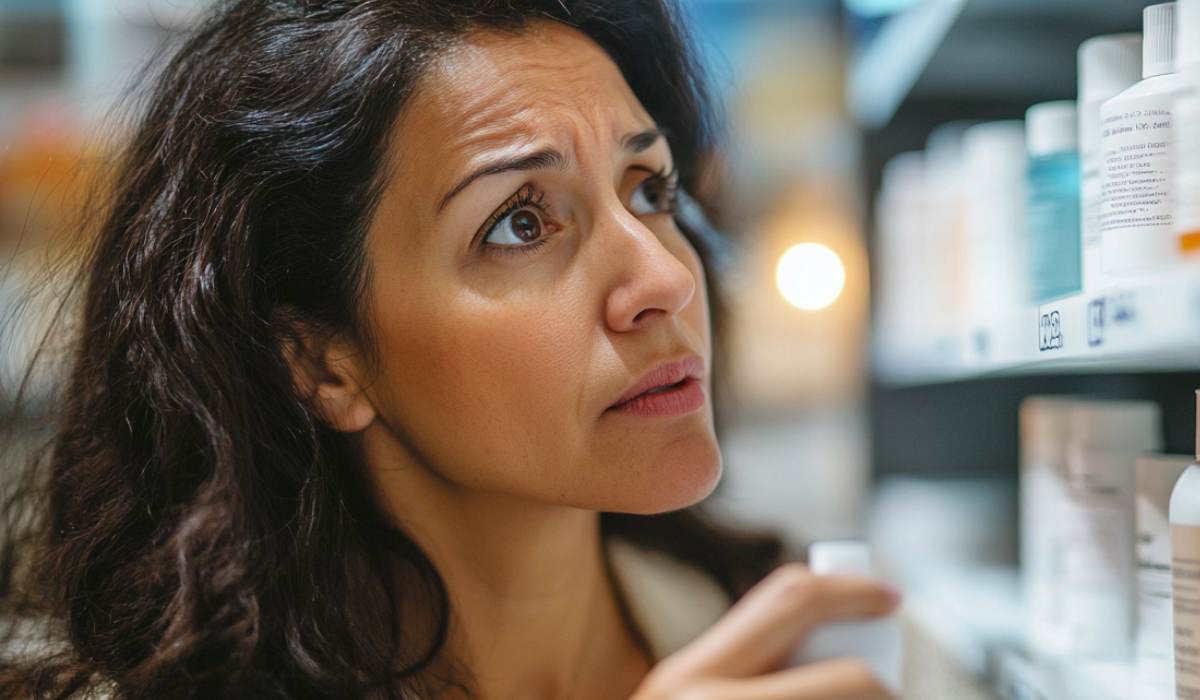The Hidden Dangers of Phenoxyethanol in Your Skincare (You Probably Applied it Today)
As a certified organic skincare formulator with over a decade of experience, I’ve witnessed the ebb and flow of countless ingredients. But few have sparked as much internal conflict as phenoxyethanol.
In my early training, phenoxyethanol was presented as the “golden child” of preservatives – a safer alternative to parabens that kept products fresh and stable.
Initially, I incorporated it into my formulations, as instructed, without checking it further as I was still learning about formulations and ingredients.
But something didn’t sit right. Call it formulator’s intuition, but I couldn’t shake the feeling that an ingredient capable of extending shelf life so dramatically might have hidden drawbacks.
After all, in the world of natural skincare, longevity often comes at a price.

This nagging doubt led me to do some research (and reevaluate ingredients I had been taught to add to my formulations).
What I discovered transformed phenoxyethanol from a (*ahem*) “trusted” ingredient to a concerning adversary in my formulations.
I no longer add it to my formulations. Haven’t done for years.
This isn’t about blindly following trends. It’s about trusting our instincts, continually educating ourselves, and staying true to the principles of safe, natural skincare.
As we uncover more about how ingredients interact with our bodies, we MUST be willing to challenge even widely accepted practices.
Below, I show you how phenoxyethanol is now raising red flags in the clean beauty world so you can make informed decisions when purchasing your skincare (and “natural” skincare).
What’s lurking in your moisturiser
It’s time for a heart-to-heart about what’s really in your skincare. Remember when we didn’t think twice about ingredient lists? Those days are GONE.
Take a look at your favourite face cream. See ‘phenoxyethanol’ in the ingredients’ list? It’s in countless products we’ve trusted for years.
So what is it? In simple terms, phenoxyethanol is a synthetic preservative. It’s made from phenol (derived from benzene) and ethylene oxide. (Take a look at the artices “Phenol and its toxicity” and “Systematic review of the scientific evidence on ethylene oxide as a human carcinogen“).
Now, the final product isn’t as harmful as its starting ingredients, but it’s far from the natural solution we’re after. Its job is to stop bacteria and fungi from growing in your creams and lotions.
But, while it’s keeping your products ‘fresh’, it might not be doing your skin any favours. As we’ve learned to be more mindful about what we eat, shouldn’t we apply the same scrutiny to what we put on our skin?
The great paraben escape: Enter phenoxyethanol
Remember the paraben panic? The skincare industry faced a dilemma: consumers wanted paraben-free products, and so “alternatives” needed to be found.
Enter phenoxyethanol. It promised effectiveness against microbes without the paraben controversy. For many, it seemed like the perfect solution.
But I hesitated. Even as phenoxyethanol gained popularity, something felt off. My instincts warned me against fully embracing this new ‘miracle’ preservative.
As I researched, my concerns grew. Were we solving one problem only to create another? In our rush to abandon parabens, had we adopted something potentially worse?
This experience reinforced a crucial lesson: in skincare, quick fixes often hide unforeseen consequences.
It’s why I now approach every ingredient with healthy skepticism, always asking: is this truly serving our skin?
Not so clean after all: The dark truth revealed
As I researched phenoxyethanol further, the “glossy facade” began to crack… Here’s what I found:
1. Skin irritation
Some users report rashes and allergic reactions. It doesn’t affect most people, but it does affect some. Check this: “Allergic reactions, such as contact dermatitis and urticaria, have been reported, albeit rarely. These reactions are uncommon, but individuals with sensitive skin should monitor for any adverse effects when using products containing phenoxyethanol” (Source).
2. Hormone disruptor?
The concern that phenoxyethanol might mimic estrogen and act as an endocrine disruptor has been explored in scientific research. Phenoxyethanol is chemically different from glycol ethers known to have estrogenic effects, such as ethylene glycol methyl ether, which are banned in some regions due to their reproductive toxicity.
While phenoxyethanol is in the same chemical family as some harmful glycol ethers, it does not share the same harmful properties. This distinction has led regulatory agencies, like the European Scientific Committee on Consumer Safety (SCCS), to conclude that phenoxyethanol is safe for use in cosmetics at concentrations up to 1%.
HOWEVER, caution is advised in using it on infants, particularly in the diaper area, due to their more sensitive skin and higher absorption potential. “The French Agency ASNM recommended that this ingredient should not be used as a preservative in cosmetic products intended for application in the nappy area (including wipes) of children aged under 3 years.” (Source)
3. Toxic buildup (overexposure to the product)
Although this preservative is deemed safe at concentrations up to 1%, it’s found in so many products—like moisturisers, toners, serums, and cleansers—that it’s easy for someone to layer multiple products without realising how much they’re using overall.
Let’s break it down: if each product has up to 1% phenoxyethanol and you use four or five of these products throughout the day, you’re layering on these doses repeatedly.
The concern is that, even though each product on its own is within safe limits, the cumulative exposure from multiple products could add up, potentially surpassing what’s considered safe, especially for sensitive individuals or children (and more and more children are using skincare products nowadays).
This is why I believe it’s crucial for formulators to be mindful of this layering effect and consider alternatives or lower concentrations where possible to avoid unnecessary overexposure.
4. Environmental impact
The environmental impact of phenoxyethanol, especially when it’s washed off our skin and ends up in our water systems, is becoming a bigger concern.
While phenoxyethanol can break down in water, this process depends on factors like temperature, sunlight, and the types of microorganisms present. Even though it does biodegrade, phenoxyethanol can still build up in aquatic environments.
Studies show that at high concentrations, phenoxyethanol can be harmful to fish and other marine life, affecting their ability to grow and reproduce.
This is worrying because it could disrupt ecosystems over time. Its impact on the environment is something we need to think about, especially given how widely it’s used and how easily it can enter our water systems.
5. Manufacturing concerns
The concern about phenoxyethanol’s production process involving potentially carcinogenic chemicals stems from the fact that it is derived from phenol and ethylene oxide, both of which are indeed hazardous substances.
Phenol is toxic and can cause severe burns, while ethylene oxide is a known carcinogen. However, the manufacturing process is tightly controlled, and the end product, phenoxyethanol, is considered safe for use in cosmetics at low concentrations.
The concern arises from whether supporting the use of a chemical that involves such hazardous substances in its creation aligns with the principles of “clean” beauty.
I think not. “Clean” beauty isn’t just about what’s in the bottle – it’s about the entire lifecycle of each ingredient.
Clean beauty’s new enemy #1
Phenoxyethanol is now facing serious scrutiny:
Rising awareness
As consumers get more educated about ingredients, they’re starting to ask tougher questions. While phenoxyethanol is being called out, it’s important to note that much of this concern comes from a mix of both accurate information and misconceptions.
Yes, it’s great that people are paying more attention, but we need to make sure the information driving these concerns is balanced and scientifically sound.
Retailer bans
It’s true that some clean beauty retailers, like Follain skincare, have chosen to ban phenoxyethanol. This definitely sends a strong message, but perhaps it’s more about aligning with brand identity and customer preferences than reflecting new safety concerns. I definitely agree because I think we need to remove synthetic products from our skincare but I have to admit that, at the moment, these types of bans probably reflect a shift in market trends rather than a sudden discovery of new risks.
Follain bans about 30 ingredients from the products in its stores. “We practice what we call a precautionary principle,” Foley said of her philosophy on which ingredients to restrict.
At a time where many clean beauty players are stepping into the role of activist, Follain’s decision to ban phenoxyethanol is equally about pushing chemical manufacturers to come up with alternatives as it is banning a potentially toxic ingredient from shelves.
Source
Nature’s preservatives can do the job
As we step away from synthetic preservatives, nature offers a treasure trove of alternatives.
These natural options not only preserve our products but often provide additional skincare benefits.
Here are some LOVELY natural preservatives that many brands are embracing:
1. Radish root ferment filtrate
This powerhouse preservative, derived from radishes, is a formulator’s dream. It’s effective against a broad spectrum of bacteria and fungi, yet gentle on the skin. Plus, it’s biodegradable, making it a win for the environment too.
2. Lactobacillus ferment
Probiotics aren’t just for your gut! Lactobacillus ferment acts as an excellent preservative while potentially improving skin health. It may help balance the skin’s microbiome, leading to a healthier, more resilient complexion.
3. Leuconostoc/radish root ferment filtrate
Another fermentation superstar, this preservative is derived from leuconostoc kimchii, a lactic acid bacteria. It’s particularly effective against gram-negative bacteria and various yeasts and moulds.
4. Essential oils
Nature’s aromatic wonders do more than smell good. Certain essential oils have potent antimicrobial properties:
- Tea tree oil: Known for its powerful antibacterial and antifungal effects
- Rosemary oil: Offers antioxidant benefits alongside preservation
- Lavender oil: Gentle yet effective, with added skin-soothing properties
5. Antioxidant-rich extracts
These multitaskers preserve products while nourishing the skin:
- Grapefruit seed extract: A potent broad-spectrum antimicrobial
- Rosemary extract: Rich in antioxidants, it fights free radicals while preserving
- Green tea extract: Offers preservation alongside other skin benefits
6. Neem oil
Derived from the neem tree, this oil has strong antimicrobial properties and is particularly useful in oil-based formulations.
While these natural options are exciting, they do present some challenges. They may not match the broad-spectrum efficacy or long shelf life of synthetic preservatives.
Formulations might require a combination of natural preservatives to achieve optimal protection.
Moreover, natural doesn’t always mean non-allergenic. As with any ingredient, patch testing is crucial, especially for those with sensitive skin. I can’t stress this enough. Many people think natural means safe!
Despite these challenges, I believe natural preservatives are the future of skincare. They align with our desire for clean, nurturing products that work in harmony with our bodies and the environment.
Your skin, your choice: The future of clean preservation
As a certified organic skincare formulator with over a decade of experience, I’ve witnessed the evolution from parabens to phenoxyethanol, and now to natural alternatives.
This journey has reinforced a crucial lesson: what we put on our skin matters deeply. The skincare industry is changing, driven by informed consumers like you who demand better, safer options.
The future of skincare preservation is bright, with nature offering a wealth of effective, skin-nurturing alternatives.
While these options may come at a higher cost, they represent an investment in your skin’s long-term health and the environment.
As we continue to uncover the power of natural ingredients, remember that your choices shape the industry.
Your skin has been with you through every stage of life—doesn’t it deserve the very best care? The decision is in your hands.
Just so you think about it further, I’ll leave you with this, from Follain skincare:
We ban things all the time, but this ingredient [phenoxyethanol] is contentious,” Foley said. “A lot of clean beauty retailers and our clean beauty brand peers are going to scoff at us and say that it’s all about the percentage you use. We need to push the envelope to continue to find safer alternatives, push brands to not include these ingredients and push chemical manufacturers to make better options. That’s how we make change.”
Follain Skincare
Further reading
https://drsandyskotnicki.com/ask-dr-sandy-phenoxyethanol-an-explainer/
https://criticalcatalyst.com/is-phenoxyethanol-safe-for-use-in-all-cosmetic-products/
https://www.isitbadforyou.com/questions/is-phenoxyethanol-bad-for-you
https://onlinelibrary.wiley.com/doi/full/10.1111/jdv.15944
https://wwd.com/feature/follain-bans-phenoxyethanol-1202773473/

